Joseph Banks Native Plants Reserve at Kareela in southern Sydney was established as a bicentenary project to commemorate Cook’s landing at Kurnell in 1770 and Joseph Banks’ botanical legacy. Although work on the planted garden did start before 1970 with members of the forerunner to the Australian Plants Society, we are declaring 2020 the 50th anniversary. APS Sutherland Group is even older, having formed in 1963 as the then Society for Growing Australian Plants.
More on YouTube
This article is based on aspects of the history reported in the APS Sutherland Group newsletters in 2020. For many more photos, see the powerpoint presentation I gave at Sutherland Group’s September 2020 meeting on the 50 years of Joseph Banks Reserve on YouTube here.
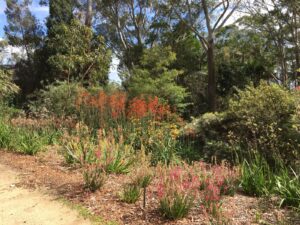
Establishing the reserve
Here are some extracts from the APS Sutherland history by Maurice Haenke:
1969: “By now, planning at State and local government level was under way for the coming Captain Cook Bicentenary in 1970. In conjunction with the Sutherland Nature Conservation Society, an approach was made to reserve land in Bates Drive, Kareela as a flora reserve, and to name it in honour of Sir Joseph Banks or Daniel Solander.”
1970: “By August the Council had provided fencing and a water supply for the Bates Drive reserve, and planting and path construction were proceeding.”
1971: “On 27 April a Management Committee was formed to “formally assume the responsibility for control, management and development of the Garden” (now the Joseph Banks Native Plants Reserve). Its President was Roy Duncan, and Hon. Secretary Alex Martin, with a committee of six members, all members of SGAP and/or Sutherland Nature Conservation Society. By the end of the year, over 1,000 new plants had been added, a circular trail built, the parking area cleared, and over 200 indigenous species listed.”
1977: “Although initially the management committee hoped to do most of the work on a voluntary basis, it became obvious that this was not practicable, and the Council assumed major responsibility, with the committee being allotted a section to care for. This it has done ably, with the help of monthly working bees of keenly active Sutherland Group members.”
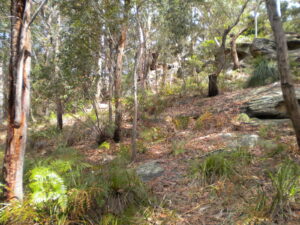
Memories from the early days – Peter Locksley
Peter Locksley of Como wrote this report of the early days in the late 1960s and early 1970s in October 2013.
****
It is a long time ago, and I can’t remember details like the names of the other people who worked there with me, but I do recall that two enthusiasts approached the Sutherland Shire Council with the idea of using land set aside by the developers of that area – it was about 10% of the area being developed – as a native plant reserve. The developers set aside the most rugged and difficult area to develop into a garden, and this suited the enthusiasts and the soon-to-be-formed committee.
They modelled their ideas on the Bankstown Council’s then existing nature reserve at Picnic Point [Sylvan Grove Native Garden]. I had also visited several times, the Australian Wildflower Park at Dee Why, called Stony Range.
I can’t actually recall how I met up with the other people, but we used to work in the then-called Sir Joseph Banks and Daniel Solander Garden, every Sunday morning. The work at that stage mainly involved clearing paths and edging their borders with logs, making steps using rocks and weeding and planting.
We used to get there about 9 am and retrieve the key to the gate from a neighbour who lived nearby. We worked till about noon and then met in the corner near the fence surrounding the school. It is a small rocky area with large stones laying about to sit on. We brought sandwiches and thermos for cups of tea, and sat there discussing what was done and it was very pleasant.
As things progressed we needed extra work to be done by the Council, eg water laid on for sprinklers systems, particularly in the area for rainforest plants, ferns etc. To do this, we attended Council meetings in the evening. These meetings were for sporting bodies committees. I recall ours was the 527 committee. Generally there was a member of the Council and the Engineer present. We had to wait whilst they went through endless questions about grass on ovals, leaking pipes, dressing rooms etc, until we could ask about our requirements.
The different areas of the gardens were laid out as eg rainforest, native mints, the circuit on the top and an area that was left as it was found. All these features remain but of course have been upgraded and expanded in ways beyond our means. This continued until the Sutherland Council took over the work.
***
Memories from the early days – Ray Witchard
Ray Witchard wrote this report of the early days in November 2009. Ray attended Sutherland Group’s 50th anniversary event in 2013.
SGAP in Sutherland Shire: Early Days by Ray Witchard
Because the general meetings were held in the City at Ultimo it was difficult to get to them from here. And prompted by the SGAP ambition to hold a flower show at Anthony Horderns, September 3-6 1963, Bede Keary of Engadine moved to form a local group. An inaugural meeting was held on 28-2-62 and among those in the group were Bede Keary, myself, Ken Metcalfe, Roy Duncan and Kerry Wheeler.
The following year at our meeting on 29-2-63 I was elected Secretary (and did it for 3 years). I put forward a plan to do some bush regeneration work in Bottle Creek [Heathcote]. Through the offices of J. Turrell this group got permission to use nursery space at South Sydney Substation to produce seedlings for Electricity Commission and ourselves. I don’t know what happened to this venture.
Early in 1967 we got to plant the Heathcote High School frontage with bottlebrushes, but the job was not properly looked after by the school. We had 2 workdays planting a garden at Kirinari Hostel [Sylvania], but this was way too premature. The group then changed its name to Sutherland, moved regular meetings to Gymea or Jannali and I lost close contact with them.
Just before 1970 we were involved in the preparatory work for the Joseph Banks Garden at Sylvania – we worked there on 3 or 4 occasions getting the weeds out of the bush. The Council connection was through Mr Utick.
I made a collection of the native plants in the area at the beginning but I don’t know what happened to it. After that I found myself busy with too many other things on the days of the SGAP meetings and so lost pretty well all contact with them.
***
The 1970s and 1980s
A management committee including APS members had been formed to oversee development and maintenance of the reserve in conjunction with Sutherland Shire Council. In 1977, although initially the committee hoped to do most of the work on a voluntary basis, it became obvious that this was not practicable, and the Council assumed major responsibility, with the committee being allotted a section to care for. It has continued to do so through monthly working bees of keenly active Sutherland Group members. Unfortunately, a sign at the reserve entrance which explained this history was removed in the 2014 masterplan works and not replaced.

In 1985, a timber walkway was constructed along the cliff line in the eastern part of the reserve below the Sunny garden. It has since been demolished.
Our Sutherland Group history notes “In September 1986, the public was invited to two open days, with free guided walks being offered, and plants, books and refreshments sold. A total of $1,100 was taken over the two days. Next year this activity was held in autumn and spring. They have been good publicity for the Group, as well as providing a handy, if variable, source of revenue.”
History of plant name labels
The metallic plant name labels at Joseph Banks Reserve are an important part of the educational experience of the reserve. As part of the 1988 bicentenary celebrations, Sutherland Group received a grant in 1987 to buy an engraving machine to make labels. We buy long strips of anodised aluminium, cut them up and engrave the plant names, then install the labels, and charge Sutherland Council per label. Aileen Phipps managed the label process right from the very beginning, but labels have been made by several people over time including Ian McPherson and Stuart Clarke and more recently John Arney. For many years, I had heard about the mysterious machine and finally saw it in action at Aileen’s garage in 2011 (John Arney in action in photo below).

Labels for now-deceased plants are stored at the reserve, so they can be re-used. As part of the removal of the old compound at the entrance in 2014, we built a new label storage unit inside the kiosk. It is interesting to see the range of plants which we used to have, and old cultivar names which are no longer available. Some old labels for plants which will never be re-planted are painted over and engraved on the other side. Keeping the labels up to date is difficult due to name changes and plant deaths and replantings, and because labels can be pulled out, thrown in the (old) ponds, buried, misplaced and used as playthings. In 2012, I compiled a spreadsheet list of all the labels installed at the reserve by broad area. We had almost 600 species labelled with 780 labels, with about 40% local to the Sydney region.
Since Sutherland Council’s 2014 and 2017 masterplan landscaping works, it has been increasingly hard to keep up with the pace of plants coming and going. Overall, there has been more change in the sunny areas than in the shadier rainforest and fern areas.
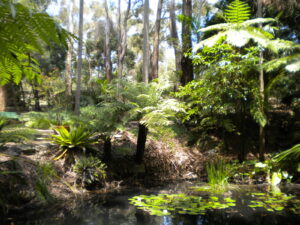
History of our interpretive signs
As well as the metallic plant name labels, a related aspect of the educational experience of the reserve is the set of interpretive signs designed and installed by Sutherland Group. In 2000, we designed and installed a set of five signs: Acacias, Banksias, Ferns, Gardening with Australian plants, and Palms (funded by the Palm Society). Lindy Selby, the daughter of members Trish and Les Fuller, designed the waratah and flannel flower drawing for the sign in the Sutherland Group garden. The signs are photo-engraved aluminium (black text on silver background) on timber backing boards on timber posts. The signs were unveiled at an official event by Sutherland councillor Genevieve Rankin, who lived in my street at the time. They have stood the test of time well, although they do have some scratches, and two signs were relocated as part of the masterplan works in 2014.
In 2010, in preparation for the reserve hosting an APS gathering, I designed some “temporary” signs to provide information. These were laminated A4 colour sheets, and installed on boards and branch posts by John Arney. These also lasted surprisingly well (better than some plants), with the laminated signs occasionally reprinted and replaced.
In 2015, Sutherland Group applied for a federal government Stronger Communities grant and we eventually received $5,000 with our group providing funds and in-kind support. I designed another 23 signs. Some of these matched the old numbered posts about features, such as the rainforest, natural area and the silver garden, and others were new such as explaining botanical names, seeds and animals, and highlighting key tree species. It was a big project to get the text right, choose appropriate illustrations, get everything checked and find a company to match the original simple but durable signs. The signs were made quickly and to a high standard by a sign company, Singleton Moore Signs, just round the corner from the reserve. After much painting, screwing, glueing and sticking, we finished installing the signs on the day of the official opening of the Stage 2 works in July 2017 (thanks very much Bruce Simpson). We now have 28 interpretive signs which provide an important source of easy-to-read information for visitors
Public events at Joseph Banks Reserve
Joseph Banks Reserve has always seemed a well kept secret, even to people who have lived in the area for years. APS Sutherland Group has introduced people to the reserve by hosting events for the community.
Our annual spring walks day started as two events a year in autumn and spring. We sold plants, bunches of members’ flowers and refreshments and led free guided walks from 10 am to 4 pm. A great team of volunteers shared the work of meeting and greeting, leading walks, selling plants and cakes (thanks Jan Taylor), chatting to visitors, and setting up and packing away. Power for the urn is vital! Over time, we refined our approach and the ever handy contents of Leonie Hogue’s crate. John Arney made an early impression with his handheld labeller to print sticker labels for everything and Aileen Phipps always had a suitable tablecloth. The numbers attending varied, largely depending on publicity in The Leader, but also affected by the weather and clashes with sport events. For several years we even letterboxed hundreds of leaflets. With support from Phil Keane (Austplants) and Sydney Wildflower Nursery, our popular plant sales were important fundraising activities for us and we bought plants for the reserve. We gave away leaflets and provided information and advice about native plants and APS.
Around 2010, we changed to one event a year in spring, often the last Sunday in August. In recent years, our schedule has been disrupted by the two rounds of Council landscaping works in 2013-2014 and 2017, and our group’s own 50th anniversary in 2013 when we hosted a day of garden visits for the public instead and had an open gardens day in 2014. Our popular Spring Walks with Angus Stewart from ABC’s Gardening Australia unfortunately highlighted the difficulties of the new car park for large numbers. Publicity is easier now with Facebook and Eventbrite.
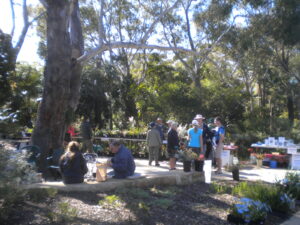
Starting in 2016, we have also developed a smaller type of event – a “walk and talk” with morning tea after, with walks on acacias, banksias and bush foods so far.
We would love to see more community events held at the reserve. It is a great location for native plant identification and nature-based activities. Sutherland Council Bushcare runs a very popular school holiday event for kids called Scamper through the Jungle, always quickly booked out, and also the annual Seniors Week walk in March.
APS involvement over 50 years
Having been established as a local group of the Society for Growing Australian Plants in 1963, APS was one of the community groups which initiated the development of the reserve, and we have continued our interest ever since. In the early days, volunteers created many rock walls, terraces and planting pockets on a steep site and their hard work is still visible forming a great framework even today.
In 2009, almost 40 years after it started, we wrote to Sutherland Council about the need to rejuvenate the reserve. After various meetings, this led to development of a master plan, which was released for public comment, and then the implementation in several stages. Stage 1 in 2014 relocated the old work compound, redesigned the entry area, introduced accessible paths and created a new lookout north over the Georges River, while the combined Stage 2 and 3 works in 2017 removed the old pond, built a new terrace and deck and installed electric BBQs.
In the media
Throughout the years, we have promoted the reserve in our local newspaper The St George and Sutherland Shire Leader in different ways, always with eyecatching photos of happy people including:
- our conservation officer Connie McPherson in the early 1990s talking about birds (in black and white)
- Aileen Phipps receiving a Cook award in 2009 for her volunteer efforts
- Leonie Hogue celebrating our Easter Show prizes with entries from the reserve over 20 years, accompanied by members who were available at the time, and Council staff
- a group of members promoting Senior Week activities
- stories and photos promoting our Spring Walks events and Wattle Day.
Our publicity efforts over the years, working with Sutherland Council, the new infrastructure at the reserve and the wonders of social media have all contributed to ever increasing awareness and visitors to the reserve. With people looking for local green space especially in this COVID year, the reserve is becoming more and more popular and means different things to each of us.
Resilience and change
Reflecting on both this year and the last 50 years, a theme of change and resilience is clear. In the early days, volunteers used the sandstone rock to create retaining walls, planting pockets and paths and changed the natural environment of the sloping site. The living environment also changes over time due to both climate and people. Just as the local bush and our own gardens are changing with climate change and the extremes of drought and temperature, the reserve has also changed and will continue to change. Shrubs and trees have grown, matured and died, but some likely original plants remain. Fire or the lack of fire affects regeneration. Plants from around Australia were introduced.
The reserve clearly has less moisture than it did 50 years, with less rainfall and fewer ponds resulting in the loss of the avenue of tree ferns and the thinning of the rainforest and fern areas. Future plantings will increasingly need to reflect the reality of a hotter, drier environment, which is an opportunity to showcase how a native garden can evolve and be colourful, enjoyable and waterwise. The history of our plant labels shows how new plants are always being introduced at the reserve, particularly even showier and hardier cultivars, from the ongoing research and development of native plants by the nursery industry.
Change beyond the boundaries of the reserve also affects the health of plants, views and the ambience of the reserve. Bates Drive has become busier over the years, and now the adjoining Sylvanvale site may be developed for housing. Another sign of change is recognising indigenous culture and perspectives. In November, a poster for NAIDOC week has been installed, but much more can be done.
The changes in the reserve also reflect the many people – all the Sutherland Council staff and APS volunteers – who have been involved in the reserve over 50 years. The year 2020 was not how we intended to celebrate 50 years of the reserve and the contribution of Joseph Banks to scientific knowledge, but more people than ever have discovered the value of their local green spaces such as Joseph Banks Native Plants Reserve. Hopefully, this interest will strengthen the future of the reserve as a place to appreciate the beauty and diversity of Australian native plants, whatever the next 50 years brings.
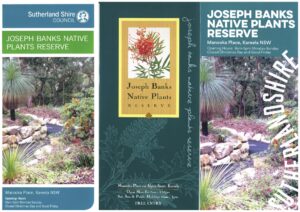
Visit Joseph Banks Reserve
- Joseph Banks Reserve is at Manooka Place, Kareela.
- Open 7 days a week 9 am to 5 pm, and to 7 pm during daylight saving.
- Electric BBQs, picnic tables, toilets and paved accessible paths.
- Free.
